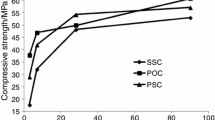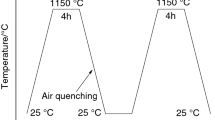Abstract
This paper investigated the effects of different proportions of Portland cement addition (0–20%) on the setting time and early-age strength of solid-waste-based sulphoaluminate cement. The mechanism of hydration process was analyzed by X-ray diffraction (XRD) technology. It was found that the incorporation of Portland cement could reduce the early-age strength of the composite cement, and shorten the setting time. When the Portland cement reached 20%, the early-age strength of the composite cement was the lowest and the setting time was the shortest. The XRD analysis demonstrated that the addition of Portland cement could accelerate the hydration process of the composite cement, and the more the Portland cement was added, the faster the hydration process of the composite cement was observed. The main reason is that the addition of Portland cement could increase the alkalinity of the composite cement and promote the hydration of anhydrous calcium sulphoaluminate. This study provides an important reference for the production of solid-waste-based composite cement.






Similar content being viewed by others
Change history
27 August 2021
A Correction to this paper has been published: https://doi.org/10.1007/s42768-021-00078-9
References
Annual Report in 2018 on Pollution prevention and control of solid waste in large, medium and large cities in China, 2018. (in Chinese). The Ministry of Environmental Protection of the People’s Republic of China.
Chen ZW, Wu SP, Li FZ, et al. Recycling of flue gas desulfurization residues in gneiss based hot mix asphalt: materials characterization and performances evaluation. Constr Build Mater. 2014;73:137–44.
Hua MJ, Wang BT, Chen LM, et al. Verification of lime and water glass stabilized FGD gypsum as road sub-base. Fuel. 2010;89(8):1813–7.
Wang JM, Bai ZK, Yang PL. Effect of byproducts of flue gas desulfurization on the soluble salts composition and chemical properties of sodic soils. PLoS One. 2013;8(8):1–14.
Wang WL, Dong Y, Ren L, et al. Experimental study on the conversion of desulfurization residues to sulphoaluminate cement. Chin J Eng Environ. 2008;6:733–7.
Wu S, Wang WL, Ren CZ, et al. Calcination of calcium sulphoaluminate cement using flue gas desulfurization gypsum as whole calcium oxide source. Constr Build Mater. 2019;228:1–9.
Ren CZ, Wang WL, Wu S, et al. Preparation of sulphoaluminate-magnesium potassium phosphate cementitious composite material under low-temperature. Constr Build Mater. 2019;202:246–53.
Wang WL, Tian W, Duan GB, et al. Research and application of preparation for sulphuraluminate based oil industrial solid waste completely as raw material. Cem Eng. 2015;6:12–5.
Ren CZ, Wang WL, Mao YP, et al. Comparative life cycle assessment of sulfoaluminate clinker production derived from industrial solid wastes and conventional raw materials. J Clean Prod. 2017;167:1314–24.
Ren CZ, Wang WL, Li GL, et al. Characteristics of solid-waste-based sulfoaluminate cementitious material being used in 3D printing and process simulation. CIESC J. 2018;69(7):3270–8.
Yao XL, Wang WL, Liu M, et al. Synergistic use of industrial solid waste mixtures to prepare ready-to-use lightweight porous concrete. J Clean Prod. 2019;211:1034–43.
Yang G, Wu T, Zhu SH, et al. Experimental study on modification of basic physical properties of sulphoaluminate cement with portland cement. Block-Brick-Tile. 2018;9:34–6.
Li HY, Ding JD, Yu X. Performance research on the multienzyme system repairing materials of portland cement and sulphoaluminate cement. Archit Technol. 2015;46(1):43–6.
Chen J, Li BX, Lu YY. Experimental study on the properties of OPC-SAC mixed cement. J Chongqing Jianzhu Univ. 2007;29(4):121–4.
Pelletier L, Winnefeld F, Lothenbach B. The ternary system Portland cement–calcium sulphoaluminate clinker–anhydrite: hydration mechanism and mortar properties. Cem Concr Compos. 2010;32(7):497–507.
Li DD. Factors influencing setting time of sulphoaluminate cement. Cem Guide New Epoch. 2002;4:36–8.
Lan MZ, Cui SP, Wang YL, et al. Study on the properties of silicate-rich cement with sulphur-aluminate cement clinker. Cement. 2004;7:12–4.
Li W, Wang GM, Jiang Y, et al. Research of physical properties and hydration mechanism of silicate-sulphoaluminate cement compound system. Mater Rev. 2014;S2:407–9.
Wan YH, Zhu JY, Zhang C, et al. Study on synergistic effect of hydration of silicate-sulphoaluminate composite cement. Sci Technol Eng. 2017;17(14):291–5.
Ding J, Wang CF. Performance of the silicate sulphoaluminate composite cement. Block-Brick-Tile. 2014;9:20–2.
Acknowledgements
The authors acknowledge the support of the National Key Research and Development Program of China (No. 2017YFC0703100) and Shandong Provincial Major Scientific and Technological Innovation Project (No. 2019JZZY020306).
Author information
Authors and Affiliations
Corresponding author
Additional information
Publisher's Note
Springer Nature remains neutral with regard to jurisdictional claims in published maps and institutional affiliations.
Rights and permissions
About this article
Cite this article
Wang, K., Wang, X., Li, J. et al. Effects of Portland cement addition on the early-age properties of solid-waste-based sulphoaluminate cement. Waste Dispos. Sustain. Energy 2, 47–53 (2020). https://doi.org/10.1007/s42768-019-00031-x
Received:
Revised:
Accepted:
Published:
Issue Date:
DOI: https://doi.org/10.1007/s42768-019-00031-x




